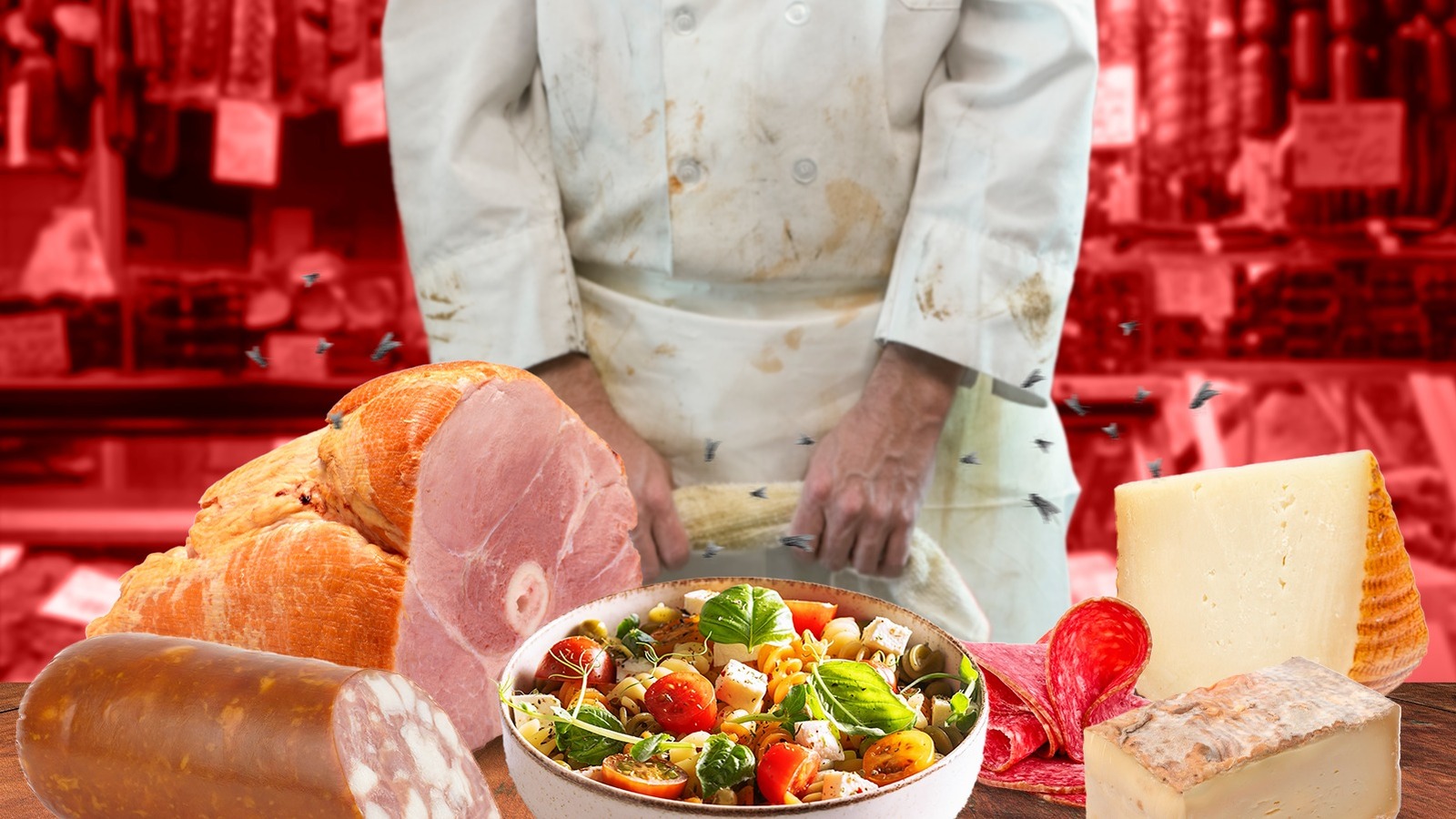There’s nothing quite like a deli meal when you need something fresh and quick to satiate your hunger on a busy day. Whether it’s a glorious, stacked pastrami sandwich, a meat sub, creamy dip, a tangy salad, or a comforting soup, delis offer variety, convenience, and deliciousness. For many of their customers, delis are a happy place, and the expectation is that the food is meant to be a little closer to homemade. When we choose to go to a deli, we’re choosing to eat something fresh and of a higher quality than getting takeout or even a prepared meal from a grocery store. However, you can’t always rely on a deli offering you quality and freshness if they follow certain unsanitary or unprofessional practices.
There’s a level of trust we hand over to food service workers as customers, with the belief that they are exercising the required food safety practices to keep everyone involved safe from food-borne illness. These things are often not in our control, so we have to look out for red flags when eating at a buffet, restaurant, or deli. As a food professional, I can say firsthand that so much of culinary school, restaurant training, or learning to work with food is about food safety. We spent weeks learning about fire and injury hazards, plus how to clean, sanitize, store, and prepare food safely before we ever touched a recipe. However, you don’t need this training to spot some concerning things at food establishments. Here are some red flags to look out for at your deli.
Servers aren’t wearing gloves and hair restraints
One of the easy signs that a deli isn’t following health safety measures: staff are not wearing the appropriate gear like gloves and hair restraints. Now, gloves aren’t always a simple topic, as they don’t prevent health problems if they’re not used properly. Gloves need to be swapped out often, or switched when you’re moving between touching meat, vegetables, cooked, or uncooked food. You also don’t want someone to use a phone or touch their face when using gloves, and then get back to touching food. So how people operate in their gloves is also something to watch out for. Depending on the situation, at times it’s more hygienic for people to not wear gloves but wash their hands regularly, which is why in certain professional kitchens, people don’t use gloves. You want to look out for these nuances before making your judgment; however, in my experience, wearing gloves is pretty standard practice for deli workers.
You don’t need professional food safety training to know that you don’t want hair in your food. It’s not only off-putting, but it’s a health hazard. This may surprise you, but our hair carries certain pathogens too. Certain bacteria, like Staphylococcus aureus, can be found in hair. If hair falls in food, it can contaminate it and make us sick. That’s why anybody handling food needs to have a hair restraint. These can be in the form of hair nets, caps, or hair bands, according to the FDA food code. If the people handling your food at the deli don’t have any of these, it’s probably not a good sign that they’re following adequate food safety measures.
Foods on display aren’t refrigerated
One of my biggest red flags at a deli is seeing prepared foods on display that aren’t refrigerated. Either they are simply sitting on the counter, or they are in a display case that isn’t cold. This doesn’t apply to foods like bread, which are fine to sit on the counter unrefrigerated. However, meats, salads, dairy, and any cooked foods need to be kept outside of the temperature “danger zone.” The FDA stipulates that this “danger zone” is between 41 and 135 degrees Fahrenheit. In this temperature range, bacteria can grow and multiply on the food. This is why food should either be refrigerated under 41 degrees Fahrenheit or kept warm above 135 degrees Fahrenheit. Of course, food can sit out of that zone as it’s being prepared to be served, but it should not be left sitting out for extended periods of time, or there’s a risk of unwanted bacteria growth.
Most delis have foods sitting out in display cases that are either refrigerated or heated — and many have both. If you see the display cases that contain a mix of warm cooked food and cold foods, that’s not a good sign (unless everything is kept cold and reheated as you order it). So inspect the place before you make your order and choose wisely.
The deli is too warm
If you step inside a deli and you feel warm, it’s a better idea to choose someplace else. This may sound harsh, but because food should be mostly kept refrigerated, a warm deli is a potential health hazard. It could be a warning sign that the food served there isn’t being kept as cold as it should be. Whether it’s the stuff on display or their stocks in the back, everything should be kept cold and below the “danger zone” mentioned above.
A certain level of warmth can be expected during winter, as you’re moving indoors from outside, but if it’s exceptionally warm, or warm even in summer, it could be that there’s a problem with the refrigeration. Sure, one doesn’t expect a deli to be cold to the point of unpleasantness, but there’s a certain amount of cold that emanates from fridges when they’re on. Feeling this slight chill would reassure me that the deli’s fridges are working and are cold enough.
The prep stations aren’t getting cleaned in between uses
An important part of food safety isn’t just how food is stored, but also about the surfaces, equipment, and utensils you’re using during the preparation. Everything should be cleaned in between uses. We all became so much more vigilant about cleaning and sanitizing things during the pandemic. Unfortunately, many of these practices didn’t endure. New data shows that food safety precautions declined after the pandemic, which is why it’s always a good idea to pay attention to any health red flags you see.
In my opinion, a green flag is when delis have their own slicer and slice meat and cheese to order. This keeps the meat or cheese from drying out from being pre-sliced, and makes everything taste fresher and better. However, even a deli slicer needs to be cleaned regularly. In truth, it’s not easy to clean a meat slicer, which means it’s highly unlikely that it will get cleaned in between every single use, but according to the FDA, a deli slicer needs to be cleaned and sanitized at least every four hours. If you’re skeptical about the appearance of the slicer at a deli, it doesn’t hurt to ask the staff how often they clean it.
Look out for orders that involve things like pepper-crusted meats or honey-glazed meats. Because of these extra toppings, the slicer should definitely be getting cleaned after each use. While it may be inconvenient to wait longer, if these meat orders are holding up the queue because they’re cleaning the slicer, that’s actually a green flag!
There’s no regular hand washing
There’s been some debate about whether it’s better to wear gloves or not while handling food. The most important thing, in my opinion, is that there’s regular hand washing. Whether the deli staff are wearing gloves or not, they should still be washing their hands in between touching various foods. Washing hands regularly helps minimize the transfer of bacteria. This is especially important in a deli if you’re eating a sandwich or salad that doesn’t get heated at any point.
In truth, we can’t expect deli workers to be washing their hands every five minutes, especially when the shop is busy. However, after every few servings, it should happen. Ideally, there should be a wash basin or sink that’s specifically meant for hand washing in the front of the house where you can see it. If the only wash basin you see is the one in the bathroom, that’s a major red flag. Food workers shouldn’t have to go to the bathroom to wash their hands, as that in itself can cause cross-contamination. Perhaps there’s a kitchen in the back that you can’t see, so it’s always better to ask than to make assumptions.
The floor is sticky
One of my pet peeves is walking into a deli and feeling stickiness under my feet. Sadly, it’s not uncommon. Sticky floors are one of the telltale signs that the deli isn’t keeping up with the hygiene standards required. Floors should be cleaned as a standard practice, especially as they can create hazardous environments that can cause people to slip and injure themselves.
A sticky floor means that liquids or foods that had fallen on the floor weren’t cleaned. In fact, they’ve been left to dry up and get sticky. Dirty floors can also promote pests and insects to be drawn in — whether it’s ants, cockroaches, or larger pests like rats. Use your discernment in these cases. A little unnoticed floor spill isn’t a surefire sign of bad hygiene, especially if it rarely happens. However, you can usually tell when the floor is dirty for longer periods of time, especially if you’ve found it sticky more than once. This can be an indication of how seriously an establishment takes its cleaning overall.
Cold cuts aren’t properly labelled or come from a packet
Delis tend to have a selection of meats and cold cuts to choose from. As many people have different dietary or religious requirements or allergies, meats must be clearly labelled. You should be able to distinguish what’s beef, pork, turkey, chicken, etc. Plus, staff should be knowledgeable about their products and able to advise you if something contains nuts or other allergens. A clearly labeled cold cut is going to enhance the experience of both the customer and the worker, and ensure the customer’s health and happiness with their order.
While not every deli has the capacity to prepare every item from scratch, it isn’t ideal if your deli gets its cold cuts out of packets. For me, this would be a red flag for multiple reasons. Firstly, packet cold cuts are made with more preservatives than fresh deli meat that’s sliced per order. Secondly, you don’t get to see the “best before” dates on these packets, and you can’t determine if they’ve been kept frozen for ages, or even defrosted safely if so. If you have a choice, choose a deli that sources its own meats from a trusted butcher and does the preparation or slicing in-house. The product will likely be of better quality and even taste better, too.
The veggies look old
Vegetables are at their best when they’re freshly prepared and eaten. We’ve all left that bag of spinach in our fridge — bought with the best intentions — a bit too late. Instead of making our meal bright and nutritious, it’s now in a puddle of its own murky juices, and has developed an unpleasant sliminess. Or your red bell peppers have started to shrivel, and you want to use them quickly before they become food waste. Now, we may make these errors at home, but you definitely don’t want this from the place you get your prepared food from. The last thing you want to see at your deli is shrivelled, mushy, or slimy vegetables.
A deli should be ordering its fresh stock regularly and replenishing its fresh veggies as they run out. If a deli is cutting corners with the number of vegetable deliveries it has or wants to save a buck by using old veggies, then it’s not serving the fresh and high-quality food you want.
The meats look too shiny/oily
We all love the marbling on our salami, or the incredible flavor of the fatty edges of our ham, bacon, or cured meat. What we don’t want is the same delicious fat to start oozing because the meat isn’t being kept refrigerated properly. However, it can be a way of telling you to avoid a place if you see the meat looking a little too oily or shiny. Sometimes, we can’t necessarily tell if the display case is cold enough. Shiny meat is a clue that it may not be, which creates the risk of the meat carrying undesirable bacteria from being kept in the temperature “danger zone” too long.
Additionally, you don’t want meat that looks or feels slimy. In my experience, slimy meat can be an indicator that it’s old or even gone bad. Look closely at the meat served in your deli, and if there’s a hint of a slimy appearance, don’t take the risk and order there.
Salad is cut without washing it first
Leafy greens and vegetables are among the top foods likely to cause food poisoning. This is because bacteria like E. coli, salmonella, and listeria can get into vegetables in various ways before ending up in your meal. Plus, a lot of leafy greens and vegetables are eaten in cold salads that aren’t exposed to cooking or any heat, which could help kill some of that bacteria. This is why it’s extra important that all fresh vegetables are thoroughly washed. So if you see vegetables being served without being washed first, it’s a huge red flag and a major health risk.
Even if the establishment is washing its produce, it shouldn’t be cutting veggies first before washing them. Chopping something like lettuce before giving it a wash can spread that contamination in the kitchen, through the knife used or the surface that it’s touched first. You could think that avoiding all salads would prevent you from contracting food-borne illness, but there’s always the risk of cross-contamination, especially if you witness meat and vegetables being prepared in the same space. These are all unsanitary practices and should be avoided at all costs.
There are flies
The last thing you want to see at any food spot is flies buzzing around. They may appear more in the summer and seem like a seasonal inevitability, but any deli, restaurant, or cafe that has flies must be doing everything in its power to get rid of them. Flies can be a sign that something is off, as they’re attracted to rotting food. If you can’t see or smell signs of food going off, but there are flies, this could be a clue that something is not right.
Flies are also able to move bacteria as they fly from one surface to another. They can’t help but carry pathogens you definitely don’t want in your food. Since their existence screams contamination, you should flee if you see them flying around in a deli. Even if the deli is doing all it can to ensure proper food safety, flies can ruin this in an instant. It’s just not worth the risk.
Sauces aren’t refrigerated
One thing that delis can tend to overlook is sauces. Sauces, like most other foods, need to be refrigerated. An open bottle of ketchup or mustard will grow bacteria in the danger zone, and if it has dairy in it, it’s even more dangerous. Sauces and other condiments can easily be forgotten on tables for extended periods of time. This isn’t good.
Always look to see if a deli refrigerates its sauces, especially the larger bottles that it uses to refill any smaller bottles that remain on the table. Plus, if there are sauce bottles on the tables, check to see if they’ve got a lot of dried up sauce on the nozzle, as that’s a sign it’s been sitting out too long, or even that the bottle hasn’t been washed in between refills. Alert the deli staff if this is the case, and it might be best to avoid the place altogether, because these are practices that should be obvious to the owners or management. If they’re not, then it does make me skeptical about what else they are not doing.





